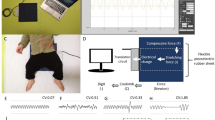Abstract
We propose a novel system for simultaneously monitoring the heart rate (HR) and breathing rate (BR) of anesthetized mice using a piezoelectric transducer (PZT) placed under the body. It is known that a PZT, which transforms mechanical vibrations into electrical signals, can detect heart sounds and breathing movements. However, no PZT system has been reported for simultaneous and continuous monitoring of HR and BR, possibly due to difficulties in eliminating noises and errors caused by the amplitude fluctuation of heart sounds and breathing movements. These difficulties were overcome by custom-designed analogue circuitry and a microprocessor program, resulting in detection of HR and BR with a high reliability compared to the values obtained from ECG and a conventional airflow sensor. We believe that this practical and easy-to-use system can be applied to a wide variety of basic and clinical research fields.









Similar content being viewed by others
References
Ansourian MN, Dripps JH, Jordan JR, Beattie GJ, Boddy K (1993) A transducer for detecting fetal breathing movements using PVDF film. Physiol Meas 14:365–372
Bartels A, Harder D (1992) Non-invasive determination of systolic blood pressure by heart sound pattern analysis. Clin Phys Physiol Meas 13:249–256
Chen D, Pibarot P, Honos G, Durand LG (1996) Estimation of pulmonary artery pressure by spectral analysis of the second heart sound. Am J Cardiol 78:785–789
Dunne LE, Brady S, Smyth B, Diamond D (2005) Initial development and testing of a novel foam-based pressure sensor for wearable sensing. J Neuroengineering Rehabil 2(1):4. DOI 10.1186/1743-0003-2-4
Durand LG, Pibarot P (1995) Digital signal processing of the phonocardiogram: review of the most recent advancements. CRC Crit Rev Biomed Eng 23:163–219
Goovaerts HG, Cohen D, Dripps JH, Mantel R, Mooney P, Jongsma HW, Dalton KJ, Geijin HP (1991) A comparative clinical study of fetal phono- and movement-sensors from Amsterdam, Cambridge and Edinburgh. J Biomed Eng 13:495–499
Hansen PB, Luisada AA, Miletich DJ, Albercht RF (1989) Phonocardiography as a monitor of cardiac performance during anesthesia. Anesth Analg 68:377–384
Imai N, Yamasaki Y (1993) Design of piezoelectric heart-murmur sensors. J Acoust Soc Jpn 49(9)
Just A, Faulhaber J, Ehmke H (2000) Autonomic cardiovascular control in conscious mice. Am J Physiol Regul Integr Comp Physiol 279:2214–2221
Luisada A, Singhal A, Knighten V (1986) New index of cardiac contractility during stress testing with treadmill. Acta Cardiol 41:31–39
Manecke GR Jr, Nemirov MA, Bicker AA, Adsumelli RN, Poppers PJ (1999) The effect of halothane on the amplitude and frequency characteristics of heart sounds in children. Anesth Analg 88:263–267
Rangayyan RM, Lehner RJ (1988) Phonocardiogram signal analysis: a review. CRC Crit Rev Biomed Eng 15:211–236
Talbert DG, Davies LW, Johnson F, Abraham N, Colley N, Southall DP (1986) Wide bandwidth fetal phonocardiography using a sensor matched to the compliance of the motherȁ9s abdominal wall. IEEE Trans Biomed Eng 33:175–180
Acknowledgments
This work has been supported by Scientific Research Grants and Grant-in-Aid for Creative Scientific Research from the Ministry of Education, Culture, Sports, Science, and Technology of Japan (15GS0301). We are grateful to Drs Nobuhiro Ban and Jeff Kershaw for helpful discussions and Ms Emiko Harada for her technical assistance.
Author information
Authors and Affiliations
Corresponding author
Rights and permissions
About this article
Cite this article
Sato, S., Yamada, K. & Inagaki, N. System for simultaneously monitoring heart and breathing rate in mice using a piezoelectric transducer. Med Bio Eng Comput 44, 353–362 (2006). https://doi.org/10.1007/s11517-006-0047-z
Received:
Accepted:
Published:
Issue Date:
DOI: https://doi.org/10.1007/s11517-006-0047-z




